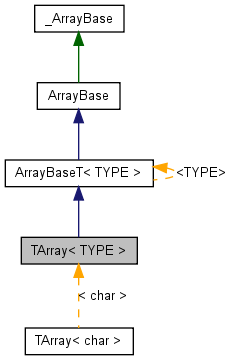kviewshell
TArray< TYPE > Class Template Reference
Dynamic array for simple types. More...
#include <Arrays.h>

Public Member Functions | |
| virtual | ~TArray () |
Arrays.h | |
| Files #"Arrays.h"# and #"Arrays.cpp"# implement three array template classes. Class {TArray} implements an array of objects of trivial types such as char#, int#, float#, etc. It is faster than general implementation for any type done in {DArray} because it does not cope with element's constructors, destructors and copy operators. Although implemented as a template, which makes it possible to incorrectly use {TArray} with non-trivial classes, it should not be done. A lot of things is shared by these three arrays. That is why there are more base classes: {itemize} {ArrayBase} defines functions independent of the elements type {ArrayBaseT} template class defining functions shared by {DArray} and {TArray} {itemize} The main difference between {GArray} (now obsolete) and these ones is the copy-on-demand strategy, which allows you to copy array objects without copying the real data. It's the same thing, which has been implemented in {GString} long ago: as long as you don't try to modify the underlying data, it may be shared between several copies of array objects. As soon as you attempt to make any changes, a private copy is created automatically and transparently for you - the procedure, that we call "copy-on-demand". Also, please note that now there is no separate class, which does fast sorting. Both {TArray} (dynamic array for trivial types) and {DArray} (dynamic array for arbitrary types) can sort their elements. { Historical comments} --- Leon chose to implement his own arrays because the STL classes were not universally available and the compilers were rarely able to deal with such a template galore. Later it became clear that there is no really good reason why arrays should be derived from containers. It was also suggested to create separate arrays implementation for simple classes and do the copy-on-demand strategy, which would allow to assign array objects without immediate copying of their elements. At this point {DArray} and {TArray} should only be used when it is critical to have the copy-on-demand feature. The {GArray} implementation is a lot more efficient. Template array classes.
| |
| TArray (int lobound, int hibound) | |
| TArray (int hibound) | |
| TArray () | |
Detailed Description
template<class TYPE>
class TArray< TYPE >
Dynamic array for simple types.
Template class TArray<TYPE># implements an array of elements of {simple} type TYPE#. {Simple} means that the type may be char#, int#, float# etc. The limitation is imposed by the way in which the TArray# is working with its elements: it's not trying to execute elements' constructors, destructors or copy operators. It's just doing bitwise copy. Except for this it's pretty much the same as {DArray}.
Please note that most of the methods are implemented in the base classes {ArrayBase} and {ArrayBaseT}.
Definition at line 644 of file Arrays.h.
Constructor & Destructor Documentation
The documentation for this class was generated from the following file:
 KDE 3.5 API Reference
KDE 3.5 API Reference